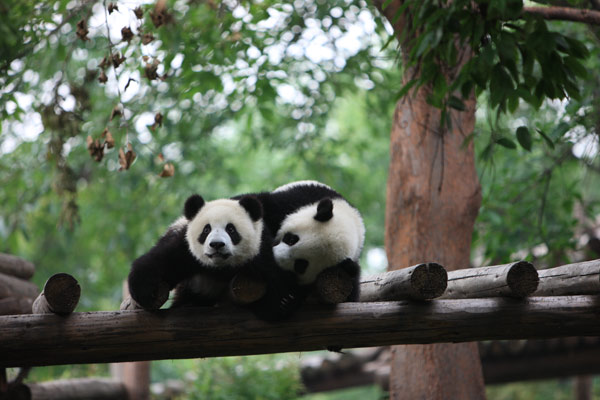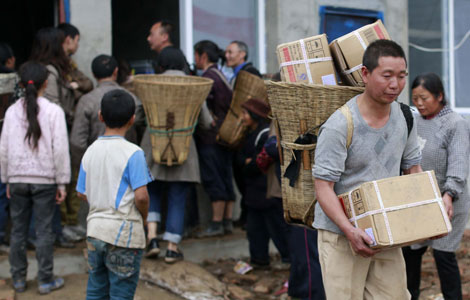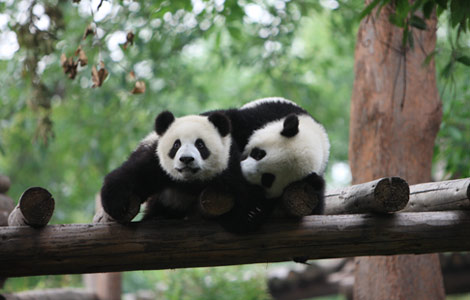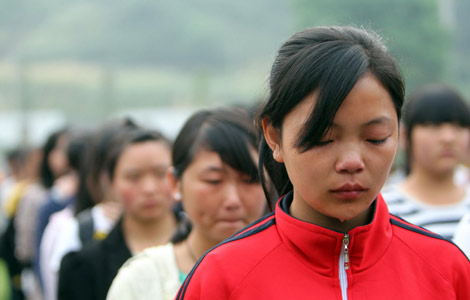Panda in her sights
Updated: 2013-04-28 08:12
By Mark Graham (China Daily)
|
||||||||
The life of these giant creatures is not as clear-cut as many people think, the co-author of a new book on the animals tells Mark Graham.
Giant panda expert Sarah Bexell sets out to debunk a few myths about China's most iconic animal in a new book, including the general perception that they are lazy and sexually shy.
The American is the co-author of Giant Pandas, Born Survivors, a serious but highly entertaining work on the severely endangered species. It is a joint project with Zhang Zhihe, director of Chengdu Research Base of Giant Panda Breeding, who has a spectacular library of panda images, many of them showcased for the first time in the book.
 |
|
Bexell is the co-author of Giant Pandas, Born Surviors, with Zhang Zhihe. Mark Graham/For China Daily |
Bexell first went to study pandas at the base almost 14 years ago and became totally mesmerized by the animals, returning for long spells every year to observe them at close quarters.
With her punchy text and Zhang's fabulous photographs, Giant Pandas, Born Survivors, is likely to be the seminal English-language work on the fast-dwindling animals. The tome endeavors to set the record straight on panda-breeding habits, in captivity and in the wild, and help highlight how quickly the population is declining.
According to Bexell, the most recent census estimated there were some 1,600 animals left in the wild, mostly around the mountainous regions of Southwestern Sichuan province, with some 300 in captivity.
"The giant panda is a conservation icon," she says. "If we can't save pandas, what hope can we have for the world?"
Bexell first came to China to work with pandas in 1999 and fell in love with them.
"You get the chance to bond when you see them 10 hours a day, you start seeing what they are thinking and why they do what they do."
Bexell is serious and sincere about her work but she is far from being a stuffy scientist. In person she is jaunty and affable, with a loud and unaffected laugh. Her open personality is reflected in the book's text: Fascinating facts are presented in a chatty way, including a section devoted to the sex life of giant pandas.
The animals are, as the world knows, famously reluctant to breed when in captivity, meaning artificial insemination techniques have to be employed. Few have seen them mating in the wild but, according to Bexell, they go through an elaborate ritual, which involves the female cooing and chirping to attract male admirers who, in turn, scrap viciously for the privilege of becoming her lover.
Says Bexell: "When a female goes into estrus she goes to a higher area, a tree or a cliff, and then begins to vocalize and males congregate around her and fight for her. This can sometimes last for days and then whoever wins gets to mate with her first.
"After he has mated with her and wandered away some of the losers might be lurking around and she might mate with them as well. It is very aggressive; you can tell the old males, they have scars like adult male lions. We are fairly certain that the females breed with different males every time, that she might never see again.
"It's a myth that they don't breed well. When they are in captivity they can't go through their mating rituals. It happens with many animals. But in the wild, they are very proficient breeders or they would have become extinct a long time ago. They have been around for 8 million years. The earlier forms of pandas were smaller and more petite; they have gotten bigger over time."
Another widely held misconception is that pandas are bone-idle creatures, just lolling around all day, snacking on the odd piece of bamboo.
 |
|
Sarah Bexell first went to Chengdu Research Base of Giant Panda Breeding in 1999 and returns for long spells every year to observe pandas at close quarters. She Yi / for China Daily |
According to Bexell they are not in the least bit indolent, they just need ample rest after expending tremendous amounts of energy on processing their favorite bamboo food. Hungry pandas have to chomp through the outer layer of bamboo before they can reach the softer inner section.
Images of pandas foraging in the wild, or resting high in the trees, are scattered liberally throughout Giant Pandas, Born Survivors. Many were taken by Zhang, who has a vast library of images and had an earlier best-seller with the book Watch Me Grow, also a collaboration with Bexell, documenting the life of a giant panda, Jing Jing, from birth.
When Bexell is asked to take a big-picture view of the state of the planet, it is not an optimistic image. The vegan scientist despairs at the greed and avarice that has led to wholesale decimation of forests and the pollution of rivers, lakes and oceans.
"Our population is too big and our consumption habits are quite frankly unethical, especially in developed countries," she says. "The more we take, and the more we have babies, we are taking away the chances of survival for every other species.
"Once we eat everything, we die too."
Most Viewed
Editor's Picks

|

|

|

|

|

|
Today's Top News
China, EU 'to renew ties'
Life goes on after Lushan earthquake
TEDA inks investment agreement with Egyptian govt
Industries post lower profit growth
China, EU agree to beef up cooperation
China's court hears Jordan suit
Top charitable donor list published
China's retrieval of lost relics needs time
US Weekly

|

|














